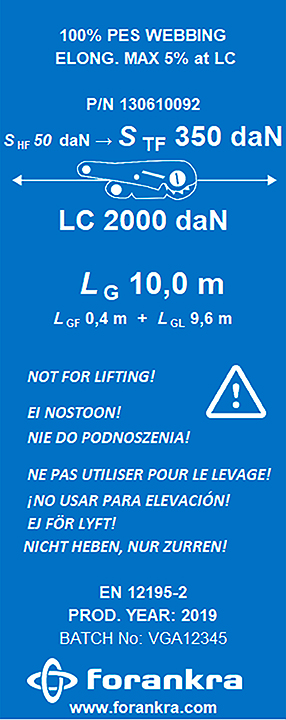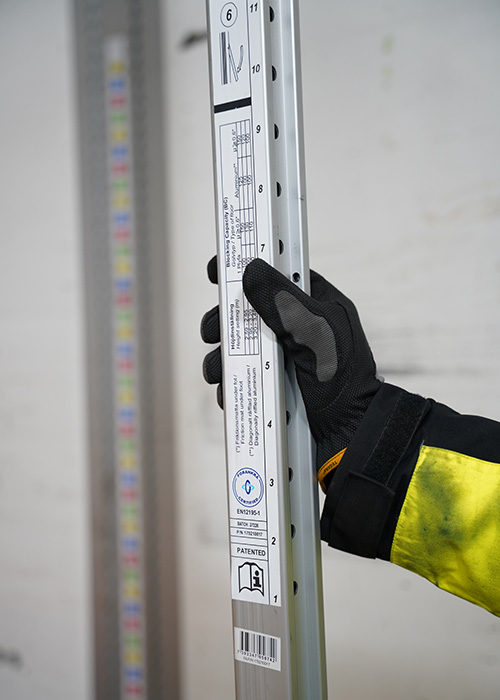Labeling of cargo securing equipment
Make sure you use approved and defect-free products. By choosing a tested and approved product to secure your cargo, you ensure that the product delivers what it promises and meets relevant requirements and regulations. Approved products always have a label or tag. Always check this label or tag before you start securing cargo.
* A lashing directly adapted to, for example, shipping may be marked and constructed in a different way, see Regulations Maritime transports.
Terminology for cargo securing
Here we explain the most widely used terms in cargo securing.
BC (Blocking Capacity)
Blocking capacity is a tested value which, together with the coefficient of friction between the cargo and the cargo floor, lets us calculate the weight of cargo that can be blocked with a cargo bar that is clamped between the floor and roof or walls, or fixed to tracks – inside a closed cargo carrier.
For fixed or detachable cargo bars mounted on or inside the cargo space of a cargo carrier (support poles, shoring profiles, etc.), the term RBC (Reference Blocking Capacity) is used. There is currently no accepted certification standard for cargo bars.
Forankra AB has developed an extensive test procedure to safeguard and document the capacity or cargo bars. Cargo bars that are tested using this procedure are labelled as described in the section below.
LC (Lashing Capacity)
LC is the lashing capacity of the cargo lashing between the end fittings, i.e. the strength used when calculating the weight of cargo that loop lashing or straight lashing can secure. LC is given in daN for webbing lashings and in kN for chain lashing. LC replaces the previous rating in tonnes. Lashing LC 2000 corresponds most closely to the previous rating of 4 tonnes.
SHF (Standard Hand Force)
The hand force for which the lashing is designed. Normally this is 50 daN (50 kg).
STF (Standard Tension Force)
The label on textile lashing equipment should provide the following information according to European standard EN 12195-2:
Labeling of textile lashing equipment
The label on textile lashing equipment should provide the following information according to European standard EN 12195-2:
LC (Lashing Capacity)*
Safe load = 2000 daN.
Lashing LC 2000 corresponds most closely to the previous rating of 4 tonnes.
SHF (Standard Hand Force)
Hand force = 50 daN
STF (Standard Tension Force)*
Pre-tension = 350 daN
Webbing material:
Polyester 100%
Manufacturer:
Forankra
Traceability (Batch):
VGA12345
Standard:
EN 12195-2
(unit daN: 1 daN = 1 kg)
* LC and STF are values used to calculate the weight of goods that can be secured.

Values refer to the label above.
Labeling of chain lashing
The marking of chain lashing contains the same information as for textile lashing equipment, but comes as an identification plate on both chain and load binder.

BC labeling on cargo bar:
• BC stands for blocking capacity and is a value used to calculate the weight of goods that the cargo bar can block.
• μ is the coefficient of friction


Labeling of dunnage bag
Dunnage bags can be marked in different ways.
The labelling should include:
• Which "level" is has (i.e how much pressure it can withstand).
• Maximum pressure the dunnage bag can withstand

